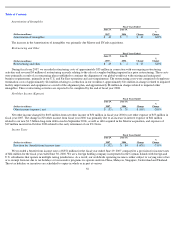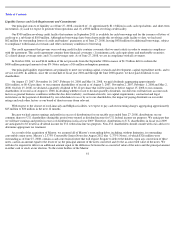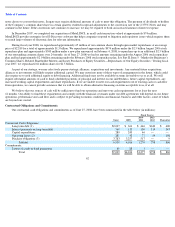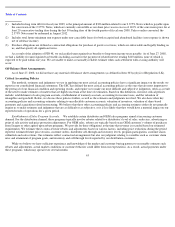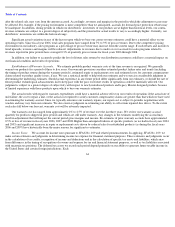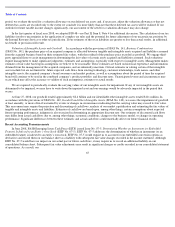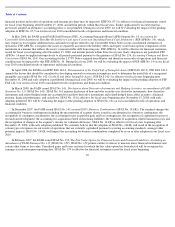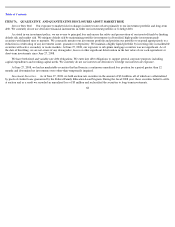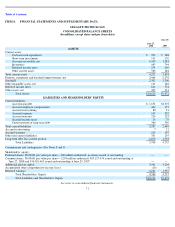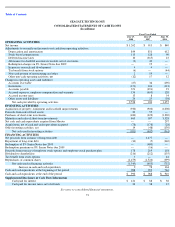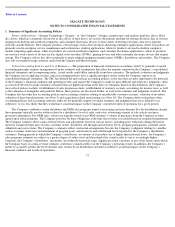Seagate 2007 Annual Report Download - page 66
Download and view the complete annual report
Please find page 66 of the 2007 Seagate annual report below. You can navigate through the pages in the report by either clicking on the pages listed below, or by using the keyword search tool below to find specific information within the annual report.
Table of Contents
period, we evaluate the need for a valuation allowance on our deferred tax assets and, if necessary, adjust the valuation allowance so that net
deferred tax assets are recorded only to the extent we conclude it is more likely than not that these deferred tax assets will be realized. If our
outlook for future taxable income changes significantly, our assessment of the need for a valuation allowance may also change.
In the first quarter of fiscal year 2008, we adopted FIN 48—see Part II, Item 8, Note 4 for additional discussion. The calculation of our tax
liabilities involves uncertainties in the application of complex tax rules and the potential for future adjustment of our uncertain tax positions by
the Internal Revenue Service or other tax jurisdiction. If our estimates of these tax liabilities are greater or less than actual results, an additional
tax benefit or provision will result.
Valuation of Intangible Assets and Goodwill. In accordance with the provisions of SFAS No. 141, Business Combinations
(SFAS No. 141), the purchase price of an acquired company is allocated between tangible and intangible assets acquired and liabilities assumed
from the acquired business based on their estimated fair values, with the residual of the purchase price recorded as goodwill. We engage third-
party appraisal firms to assist management in determining the fair values of certain assets acquired and liabilities assumed. Such valuations
require management to make significant judgments, estimates and assumptions, especially with respect to intangible assets. Management makes
estimates of fair value based upon assumptions we believe to be reasonable. These estimates are based on historical experience and information
obtained from the management of the acquired companies, and are inherently uncertain. Critical estimates in valuing certain of the intangible
assets include but are not limited to: future expected cash flows from existing technology, customer relationships, trade names, and other
intangible assets; the acquired company’s brand awareness and market position, as well as assumptions about the period of time the acquired
brand will continue to be used in the combined company’s product portfolio; and discount rates. Unanticipated events and circumstances may
occur which may affect the accuracy or validity of such assumptions, estimates or actual results.
We are required to periodically evaluate the carrying values of our intangible assets for impairment. If any of our intangible assets are
determined to be impaired, we may have to write down the impaired asset and our earnings would be adversely impacted in the period that
occurs.
At June 27, 2008, our goodwill totaled approximately $2.4 billion and our identifiable other intangible assets totaled $111 million. In
accordance with the provisions of SFAS No. 142, Goodwill and Other Intangible Assets (SFAS No. 142), we assess the impairment of goodwill
at least annually, or more often if warranted by events or changes in circumstances indicating that the carrying value may exceed its fair value.
This assessment may require the projection and discounting of cash flows, analysis of our market capitalization and estimating the fair values of
tangible and intangible assets and liabilities. Estimates of cash flow are based upon, among other things, certain assumptions about expected
future operating performance; judgment is also exercised in determining an appropriate discount rate. Our estimates of discounted cash flows
may differ from actual cash flows due to, among other things, economic conditions, changes to the business model, or changes in operating
performance. Significant differences between these estimates and actual cash flows could materially affect our future financial results.
Recent Accounting Pronouncements
In June 2008, FASB Emerging Issues Task Force (EITF) issued Issue No. 07-5, Determining Whether an Instrument (or Embedded
Feature) Is Indexed to an Entity
’s Own Stock (EITF No. 07-5). EITF No. 07-5 addresses the determination of whether an instrument (or an
embedded feature) is indexed to an entity’s own stock. EITF No. 07-5 would require us to account for our embedded conversion options as
derivatives and record them on our balance sheet as a liability with subsequent fair value changes recorded in the income statement. Although
EITF No. 07-5 would have no impact on our actual past or future cash flows, it may require us to record an additional liability on our
consolidated balance sheet. Subsequent fair value adjustments may result in significant charges or credits recorded in our consolidated statement
of operations. As a result, our
65



